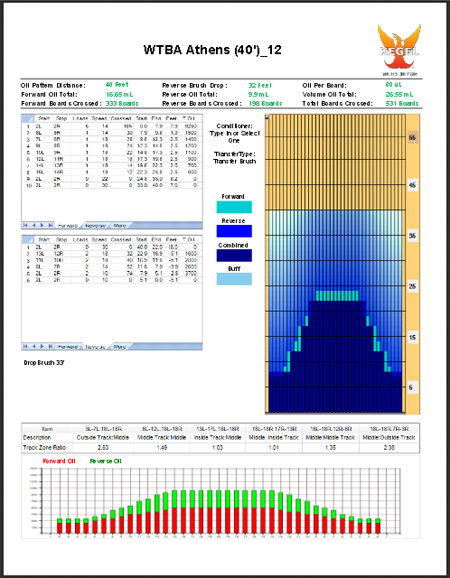Reading The Lane
Reading the Lane
In league, tournament or professional play, knowing how to play the lanes is crucial. A 300 game is achieved by knowing how to make the right moves at the right time, not just repeating shots. Staying “ahead” of the lanes as they go through transition is key to perfection.
Most bowlers know about the arrows, but finding the breakpoint and adjusting to that part of the lane is vital to giving you more area to play with. A quick method to determine where the ball should be leaving the end of the oil pattern is to simply apply the rule of 31. How do we do this? Subtract the number 31 from the distance of the oil pattern; this will give you the board number where your ball should exit the pattern. Nothing is definite, but this is a good guideline to finding the correct area to start and then make adjustments based off your ball reaction.
Example: Pattern length 40 ft. - 31 = 9 board
NOTE: On a 40ft. pattern you want to see the ball exit the pattern (breakpoint) around the 9 board.

Distance
Lane pattern distance dictates “breakpoint.” A bowler’s breakpoint is where their ball is furthest away from the pocket before making its move toward the headpin. Short distance patterns, 36’ and shorter, tend to have breakpoints closer to the gutter, while medium distance patterns, 37’-42’, are usually between the 8-12 boards. Long distance oil patterns, 42’ and further, will have breakpoints closer to the pocket or around boards 13-16.

A breakpoint can be reached from multiple launch angles depending on the oil pattern.
Beyond throwing the ball, making moves and knowing where to play, execution of the shot is essential to being successful. Let’s take a look at the many components to making the right moves and decisions and see how they factor in together.
Lanes
Take into consideration the type of lane surface you will be bowling on. Wood lanes tend to hook more and/or earlier, whereas synthetic lane surfaces tend to be a little tighter and allow the ball to get down the lane a little further. If you’re a high rev-rate player, you may need to make adjustments sooner, while a straighter player will probably move less to combat the condition. Moves on the approach and lanes are done by moving your feet and your eyes to adjust your angle. Moving one or both is a personal preference geared toward your game and how you see your ball path.
.jpg)
Oil
As the lane pattern goes through transition, adjustments needed to stay in the pocket and score will be slightly different from player to player. Some may need to adjust their feet, some their eyes (target), some will get it done by changing bowling balls or adjusting speed and loft.
When bowling a tournament, watching the bowlers on the pair you are moving to can help you make good decisions about any adjustments you might make in the first frame. If you notice most of the bowlers playing the same area, you can expect that zone to change quickly. Again, be aware of your surroundings and make adjustments a little more quickly than you normally do in league play.
Making adjustments to the condition using hand positions or ball speed are good, but having the right ball can make all the difference in being comfortable and repeating shots.
When you are bowling on a fresh oil pattern, starting with a stronger ball will allow the ball to be smoother off the hook spot giving you the information needed to determine what ball to use, where to play, type of release and speed. Watch how your ball rolls off the breakpoint and make your moves accordingly. As the lanes break down, switching to a weaker ball that skids down the lane a little further may help you combat early hook in the front part of the lane.
.jpg)
Shape
There are 39 boards on a lane and it is approximately 42 inches wide, which does not seem like a lot of room to play with compared to the length of the lane, which is 60 feet. (Foul line to head pin) Learning to see where your ball starts to read the pattern and watching the reaction as it is heading toward the pocket is more valuable than reading the lane left to right. Why limit yourself, when you have 60 feet to play with?
Reading a lane condition front to back is identifying where the ball begins to lose speed. If a ball loses a lot of speed in the first 20 feet, you can expect less hook power or a smoother backend motion down lane. If the ball doesn’t lose speed in the front or middle sections of the lane, you can expect more hook down lane creating a stronger back-end reaction towards the pins.
TIP: Practice with two balls, a stronger (early rolling ball) and a weaker (later rolling ball). Get lined up with one ball and then throw both of them in the same place, the same way. Train your eyes to see how early or late the ball starts to make its move toward the pocket. Watching ball reaction, knowing your equipment and knowing your breakpoint are keys to being one step ahead of your opponent.






